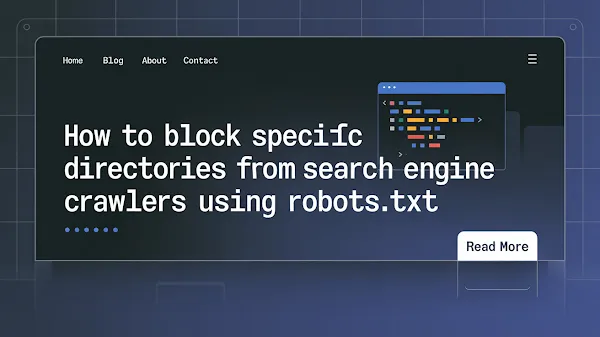How to Block Specific Directories from Search Engine Crawlers Using Robots.txt
Search engine crawlers systematically scan websites to index content, but certain directories—like admin panels, temporary files, or development folders—often contain sensitive or irrelevant material that shouldn't appear in search results. The robots.txt file provides a critical first line of defense for controlling crawler access. This comprehensive guide demonstrates how to effectively block specific directories using this essential protocol.
Understanding Robots.txt Fundamentals
Located in your website's root directory (e.g., https://www.example.com/robots.txt), the robots.txt file serves as a protocol that instructs compliant crawlers which areas of your site they may access. This text file is the first resource crawlers check before scanning your content.
Core Syntax Structure
User-agent: [crawler-name]
Disallow: [directory-path]
Allow: [exception-path]Step-by-Step Implementation Guide
1. Identify Target Directories
Audit your website structure to determine which directories require blocking. Common examples:
/admin/(Control panels)/tmp/(Temporary files)/staging/(Development environments)/user-data/(Private content)
2. Create/Edit Your Robots.txt File
Place a plain text file named robots.txt in your root directory. Use this template to block directories:
User-agent: *
Disallow: /admin/
Disallow: /tmp/
Disallow: /staging/
Disallow: /user-data/Key parameters: User-agent: * applies rules to all crawlers. Each Disallow line blocks one directory path.
3. Target Specific Search Engines (Optional)
To customize rules for particular crawlers:
User-agent: Googlebot
Disallow: /private/
User-agent: Bingbot
Disallow: /backup/4. Create Selective Exceptions
Allow access to specific subdirectories within blocked paths:
User-agent: *
Disallow: /private/
Allow: /private/public-resources/Critical Implementation Notes
- Path Precision: Use trailing slashes (
/admin/) to block entire directories - Case Sensitivity:
/Admin/≠/admin/(match exact casing) - Wildcard Rules: Use
Disallow: /*.php$to block all PHP files - Index vs Access: Blocking access ≠ blocking indexing (use
noindexmeta tags for indexing control)
Validation & Testing
Always verify your configuration using:
- Google Search Console's Robots Testing Tool
- Third-party validators like TechnicalSEO.com/robots-txt/
- Direct URL checks:
yourdomain.com/robots.txt
Security Considerations
Important: robots.txt is publicly accessible and shouldn't protect sensitive data. For confidential content:
- Implement password authentication
- Use
noindexmeta tags - Employ IP whitelisting
- Remember: Malicious bots may ignore robots.txt rules
Maintenance Best Practices
Regularly audit your robots.txt file to:
- Remove references to obsolete directories
- Verify search engine compliance
- Ensure new development areas are properly restricted
- Check for syntax errors using validation tools
Conclusion
Properly configured robots.txt files serve as essential gatekeepers for search engine crawlers, preventing sensitive or irrelevant directories from appearing in search results. By implementing the precise blocking techniques outlined above and conducting regular audits, you maintain greater control over your site's visibility while optimizing crawl efficiency for search engines.

Join the conversation